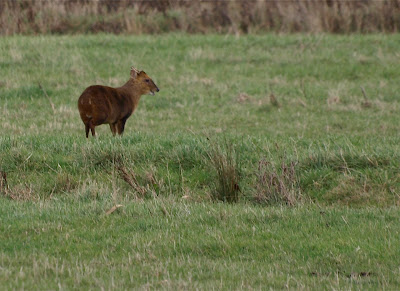For a start, the birds, of all species, have been fairly absent from the feeders with only the odd flourish as a raiding party of Long-Tailed Tits descends, or a rabble of various species stumbles across some easy feeding whilst moving away from their parents territory. We have chalked this up to the mild weather still allowing for plenty of natural food to be available in the area - why would you want to stop at McDonald's when you can have a fresh food banquet?
However, over the last week or so the numbers of birds visiting the garden has started to increase and we were very happy to see that Redpolls are essentially beginning to take up residence as they have done in previous years (one year to the extent that they roosted in the back hedge and then just moved a few metres to feed during daylight). All of this years Redpolls have been Lesser (to the best of our knowledge and ID skill) but last year we did have at least two Mealy (Common) Redpolls who were regular visitors alongside the Lessers.
This years Redpolls are different though - mainly because they are red ... and I'm not just talking about their 'polls'. In previous years, just before they leave us in Spring, some have began to show a hint of red on their breast; but this year they have arrived very red!
Below, you can see photos taken in February 2010 (two winters ago) which clearly show no sign of red on the breast despite being closer to the breeding season than they are now. I should now take the opportunity to apologise for the quality of some of these photos, Redpolls on the feeder offer too good an opportunity to miss to play with some digiscoping (and they are all taken through a window).
 |
| Lesser Redpolls, Ixer Garden, Feb. 2010 |
Next, a couple of photos from January 2011 (last winter) which is clearly closer to this time of year and again there is no sign of red on the breast at all.
 |
| Lesser Redpolls, Ixer Garden, Jan. 2011 |
Finally, here are two photos taken today (31/12/11) which show just how red some of the birds are this winter.
| Lesser Redpolls, Ixer Garden, Dec. 2011 |
So the big question is, why are they so different this year?
The answer, I really don't know!
My best guess would be something to do with the extremely mild weather, but I'm struggling to work out exactly why that would affect them. Is their winter moult temperature dependent so they have not fully moulted because it has been mild? Have they already adopted their breeding plumage because of the 'spring-like' feel about the weather (I even heard a chaffinch singing a week ago - weird!)? Is there an increased number of males staying in this area because of the mild weather?
Any suggestions or answers would be most welcome. Thanks!




